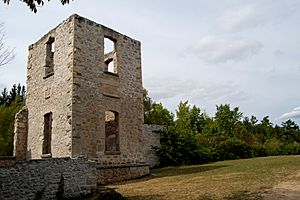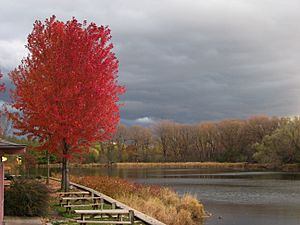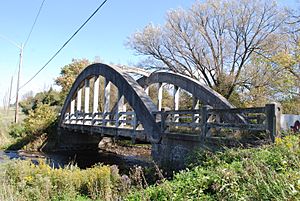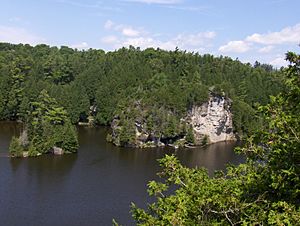Eramosa River facts for kids
Quick facts for kids Eramosa River |
|
|---|---|
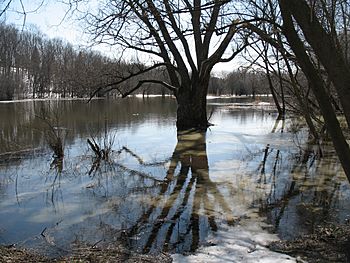
Flooded Eramosa River in Guelph in early spring
|
|
| Country | Canada |
| Province | Ontario |
| Physical characteristics | |
| Main source | near Erin, Ontario |
| River mouth | Speed River at Guelph, Ontario |
The Eramosa River is a river in Wellington County, southwestern Ontario. It starts near Erin, Ontario, and flows southwest through the city of Guelph. In Guelph, it joins the Speed River, which then flows into the Grand River in Cambridge. The river's name likely comes from a Mississauga word, um-ne-mo-sah, which means "black dog" or "dead dog".
Contents
History of the Eramosa River
The Eramosa River has a long and interesting history. In 1821, John Harris settled in the Rockwood area. He built the very first mill on the Eramosa River. Early settlers used stone from the riverbanks to build many mills. One important mill was the Rockwood Woolen Mills, built in 1867. The first wooden mill was destroyed in 1880. It was rebuilt with stone in 1884. This mill later used steam power and then electricity before closing in 1925.
For a time, parts of the Eramosa River were used for waste disposal. A large waste site on Guelph's York Road was located by the river. It was closed in the early 1960s. After that, it was covered with soil and turned into an urban park.
Fun on the River
In 1870, the Guelph Boating Club was started. Rowing became very popular in Canada around this time. By 1873, the river was a busy place for fun activities. One spot, called "Paradise," had swings, picnic areas, and even a shooting range. Another place, "the Rocks," was popular for boating. People would row there to look for fossils, pick berries, and hunt ducks.
In 1886, Victoria Park opened along the Eramosa River. It quickly became a favorite summer spot for boaters and campers. The Boathouse, a well-known building, was built there. It allowed people to rent boats to enjoy the river. In the 1910s, the Eramosa River was even featured on postcards.
Building and Development
Charles Ambrose Zavitz, a professor, thought the "Paradise" area was good for small farms. It was a floodplain and too wet for big farm machines. In 1909, the first buildings of the Ontario Reformatory were built by the Eramosa River. People working there helped build many structures. The "Rocks" area was used as a quarry. Materials like lime and crushed rock were mined there for construction. A small railway connected the prison and the quarry. This railway crossed the Eramosa River on a bridge built by the workers.
The cornerstone of the Ontario Reformatory was placed by Premier James Whitney in 1911. He crossed a concrete bridge, also built by the workers, to get to the prison. Workers at the Reformatory also helped with landscaping and creating ponds along the river. The Ontario Reformatory closed in 2001.
The Rookwood Harris Woolen Mill, built in 1867, was closed in 1925. This was the first textile mill in the area. Its machines were powered by the river's flowing water. A. J. Casson, a famous painter from the Group of Seven, once painted the mill and the Eramosa River. The building became a local landmark. After a fire in 1967, it was closed to the public in 2007 because it was unsafe. The Rockwood Conservation Area restored the building, and it reopened in 2011.
Environmental Concerns
In 2016, a company's distribution center accidentally spilled thousands of tiny plastic beads into storm drains. These beads ended up in the Eramosa River. A local environmentalist found many bags of these beads. This led to an investigation by the Ministry of the Environment. The company then cleaned up thousands of beads from the river's banks. Even though the company is still working to clean the river, plastic beads were still found in 2019.
In 2019, the city of Guelph had a problem with a new sewer line. This caused a large amount of sewage to overflow into the Eramosa River. A few days later, a smaller spill also happened. Also in early 2019, the rare Charitable Research Reserve created the Eramosa River Conservation Corridor. They bought land along the river in Rockwood to protect it.
Bridges Over the Eramosa
Many bridges have been built to cross the Eramosa River over the years.
In 1888, the Guelph Junction Railway built a bridge over the river. It was located between Guelph's Royal City Jaycees Park and Victoria Park.
A three-arched concrete bridge was built in 1910 by workers from the Ontario Reformatory. Another wooden bridge was built to connect the quarry to the Reformatory. The Benham Bridge, about 12.2 metres (40 ft) long, was also built in 1910. It crosses the Eramosa on Eramosa-Erin Townline Road.
MacQuillan's Bridge, a 21.3 metres (70 ft) concrete bridge, was built in 1916. It replaced an older wooden bridge. This bridge is also known as the Stone Road Bridge. It was named an Ontario Heritage Bridge in 2004. It is located between Guelph and Puslinch.
The Eramosa River Bridge, about 15.24 metres (50.0 ft) long, was built in 1953. It was first called the Ospringe Bridge. It helps people travel along Wellington Road 124 in Erin, Ontario. This bridge is near the springs that feed the river.
The Lattice Covered Bridge was built in 1992 by many volunteers. It is one of only two lattice bridges in Ontario. It is 44 metres (144 ft) long and based on a design from the 1800s.
River Features and Environment
The Eramosa River gets its water from groundwater springs. It flows along a path carved by ancient glaciers. The riverbanks are often marshy. Artificial structures like levees and ponds help control the river's floodplain. The Guelph Dam, at the end of the Eramosa, also helps manage the river's flow and depth. When the dam is open, the water level can become very low.
The Eramosa flows through an area with over 200 glacial potholes near Rockwood. One of the biggest is the Devil's Well. It is 6.4 metres (21 ft) wide at the top and 13.1 metres (43 ft) deep. These glacial features are found in the Rockwood Conservation Area. Here, the bluffs are 5–30 metres (16–98 ft) deep and 7–200 metres (23–656 ft) wide. All these landforms were created when the Laurentide Ice Sheet melted away long ago.
Erosion has also uncovered parts of the Eramosa Formation. This is a Silurian geological formation known for having fossils.
Water Quality
Compared to other rivers in the Grand River watershed, the Eramosa has low levels of certain chemicals like phosphorus and nitrogen. The Eramosa's water quality is best near its source. However, it becomes more polluted as it flows through Guelph. This is due to waste from industries and old waste sites. Erosion often uncovers old trash on the riverbanks, so cleanups are needed every year.
Even with some pollution, the Eramosa is clean enough for Guelph to use its water for drinking. The water is treated first. A 2019 study found that the upper parts of the Eramosa River have not been much affected by invasive plants. The areas along the river have also been left natural. Some endangered species even live there.
Plants and Animals
The Eramosa River provides water for the local ecosystem. It is mostly surrounded by the Eastern Great Lakes lowland forest. This type of forest covers much of southeastern Ontario. The Eramosa River and its surrounding areas are considered important "greenlands" by Wellington County. They are protected by the Grand River Conservation Authority.
Trees like conifers grow along the riverbanks.
Beavers live and build dams in the Eramosa River. Hundreds of bird species live in the area. Gulls and small passerine birds are common near where the Eramosa and Speed Rivers meet. Many types of ducks, like ring-necked ducks and mallards, also live here. Canadian geese are common too.
Many fish species live in the river. These include largemouth bass, smallmouth bass, northern pike, and different kinds of trout.
The undeveloped parts of the Eramosa River are a safe home for many at-risk and endangered species. Birds like Bobolinks and golden-winged warblers live here. Rare plants like rock polypody and goldthread are also found. Animals such as Blanding's turtles, northern map turtles, and monarch butterflies have been seen in the area.
Fun Activities
The Eramosa River Trail in Guelph is a great place to explore. It is about 4.1 kilometres (2.5 mi) long. The trail passes through Eramosa River Park. It is open all year, and you can even go snowshoeing in winter. Part of the trail is also wheelchair accessible. This trail is part of a larger 20 kilometres (12 mi) network of trails around the Eramosa River.
You can go camping and do other outdoor activities at Rockwood Conservation Area in Rockwood. There is a beach where you can swim. This park has the most glacial landforms along the Eramosa River. You can also go exploring in its many limestone caves. The caves are closed in winter to protect bats. The park is open in winter for hiking.
Boating on the Eramosa River has been popular since the 1800s. You can canoe on the Eramosa. Sometimes, fallen trees and rocks can be obstacles. Canoe trips can start near the river's beginning in Erin or further downstream in Guelph/Eramosa. You can paddle all the way to the Guelph Dam. Along the way, you will see homes and local landmarks. When the Guelph Dam is open, the water can get very shallow. This means you might have to get out and pull your canoe.
Even in the city parts of the Eramosa, fishing is a popular activity. People can catch fish from the river.


